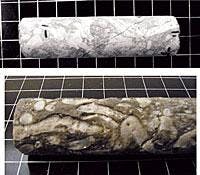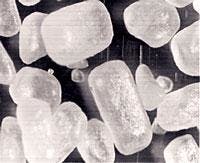Encapsulated acid improves facture results
Matthew Blauch
Gary Funkhouser
Halliburton Energy Services
As more difficult and remote carbonate provinces are discovered, engineers and operators are faced with significant technical and logistical challenges to enhanced production. These hostile environments make large fracture acidizing operations daunting experiences. All too often, highly variable reservoirs, logistical pitfalls, or environmental issues conspire to cause lower-than-expected production results.
A revolutionary new concept known as encapsulated acid (EA) technology may soon provide a way to overcome these barriers to production enhancement. Halliburton Energy Services and researchers from major operating companies are jointly developing EA technology for application to fracture acidizing treatments.
Fracture acidizing
In fracture acidizing, the ideal, but rarely achieved, outcome is a fracture plane that is continuously conductive from the wellbore all the way to the tip to provide maximum production enhancement from the surrounding rock. To be effective, etched fracture surfaces must retain sufficient conductivity for production enhancement after fracture closure.
Historically, carbonate fracture acidizing has experienced limited success in geologic reservoirs characterized by high-closure stress or temperatures above 250° F. Although a large mass of rock may be dissolved, if the resultant fracture face dissolution does not render the surfaces with sufficient differential relief, the fracture conductivity under closure stress will be low. If the acid spends too quickly, excessive spending and acid leakoff near the wellbore will result in little or no conductivity toward the fracture tip. Lack of live acid penetration deep along the fracture plane will result in very short conductive fractures.
Differential etching and citric acid
One key, and somewhat radical, concept linked to EA development is the idea that higher conductivity can be generated with less dissolving power. During concept development, researchers discovered that testing this hypothesis would be their greatest challenge. New methods for laboratory testing had to be developed. Such developments centered on evaluating the effects of performing fracture etching-type studies and carbonate rock's natural heterogeneity and differential etch characteristics.
The first experimental product currently being field-tested is encapsulated citric acid, which has a much lower bulk dissolution capacity than hydrochloric acid (HCl). Interestingly, citric acid's low dissolving power shows a higher laboratory-generated etched fracture conductivity at higher stresses than HCl systems. This surprising result supports the differential etch concept, in which a little differential etching goes a long way toward creating fracture conductivity. Characteristically, a weak organic acid provides numerous micro channels rather than the typical single-flow channels or uniform homogeneous etching observed with bulk solutions of HCl. Traditional methods to retard or delay the reaction of hydrochloric acid include acid gelation, acid-in-oil emulsification, or adsorption of oil-wetting surfactants on the rock face. All have their limitations.
The most promising traditional approach involves creation of an acid emulsion within an oil carrier fluid. This is technically a form of encapsulation, but requires handling of liquid hydrocarbons, a task that may pose significant logistical difficulties and causes high-frictional pumping-pressure loss. Researchers compared data generated using the emulsion approach to that of encapsulated acid. Results dramatically favored encapsulated acid in terms of conductivity generation at elevated stress and temperature.
Extra benefits
Several added benefits of acid encapsulation were discovered during the laboratory evaluation phase. One beneficial feature is the fluid loss control provided by the non-reactive acid capsules prior to release. Upon release, the acid is already in a location where differential etching is enhanced. Hence, conventional fluid loss control additives and heavy gel loadings can be eliminated or reduced. Matrix core testing and leak-off measurements performed while circulating EA slurry across a core face provided important insights into the mechanisms of this dynamic process.
Another benefit of EA is the ability to pump it as a slurry using a conventional hydraulic fracturing fluid. Most water-based gel fracturing fluids are not stable and lose viscosity in contact with live acid. Encapsulation provides needed isolation of the acid from the fluid during the critical downhole transportation phase. To be considered for a well treatment application, an EA must be able to survive transport through the surface equipment, including:
- Auger transfer to the slurry processor
- Blending equipment
- High-pressure pumps.
Full-scale testing was performed to evaluate integrity of the capsules after passing through the surface equipment. Diagnostic examination using onsite microscopy and release tests during a field test demonstrated the survivability of a 1-ppg slurry of EA.
Despite encouraging early laboratory successes, a number of potential technical barriers needed to be tackled to build a case for using EA. Solid acids suitable for macro-encapsulation are relatively limited. In addition, many of the potential acids exhibit some form of tendency for adverse secondary precipitation or reaction with calcium ions released during carbonate rock dissolution.
Cost of raw material was also found to be a barrier for commercial application. Citric acid has the potential to produce calcium citrate upon reaction with calcium carbonate. Surprisingly, very little information has been published on this subject. Researchers theorized that the precipitation reaction may be limited by downhole pressure conditions.
Based on matrix core testing and chemical reactions designed to simulate downhole reactions, researchers at Halliburton discovered that calcium citrate formation is more complex and less likely to form in situ than commonly perceived. As a result, encapsulated citric acid became a candidate for product development and commercial deployment.
Two fundamental mechanisms have been developed for current experimental versions of EA:
- Diffusion dominated osmotic exchange release
- Thermal-melt release of protective coating.
The encapsulated coating can be engineered to obtain a range of release rates and release temperature profiles by altering either the coating composition or the diffusion properties of the coating membrane. Applications designed for carbonate acidizing have focused on coating characteristics of low diffusive release and narrow melt points to obtain triggered thermal release.
Thermal models provide the design parameters for determining the cool-down or rate-dependent thermal environment required to obtain the desired depth of pre-release penetration down the fracture length.
In the near future, researchers plan to globally expand field trials of this new technology in selected key carbonate provinces, expand the available acid encapsulates, and develop novel methods to encapsulate a variety of liquids, including hydrochloric acid.
null
Photomicrograph of encapsulated citric acid version of encapsulated acid currently being field-tested. Each capsule is uniformly coated on the proppant-sized crystals of citric acid. The crystal habit of the solid acid makes it well suited for encapsulation and bulk handling. (Below) Core plug following removal from high-pressure stirring autoclave following reaction with encapsulated acid gel slurry at 212° F for 60 min.



